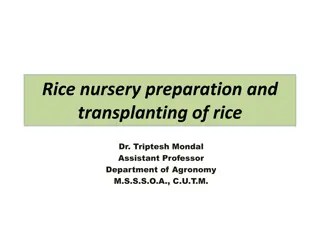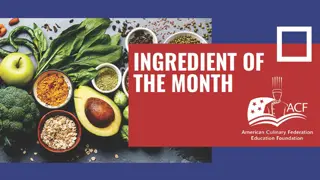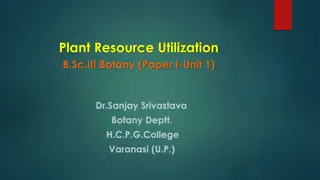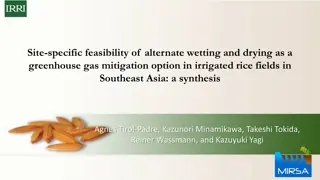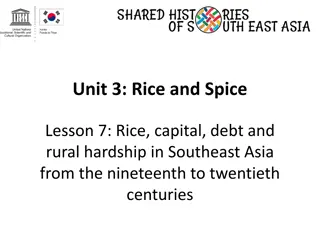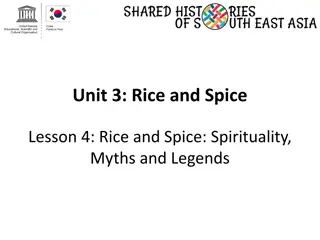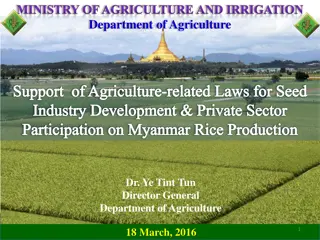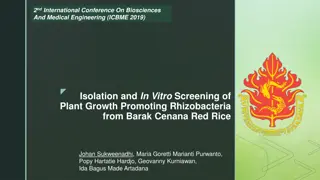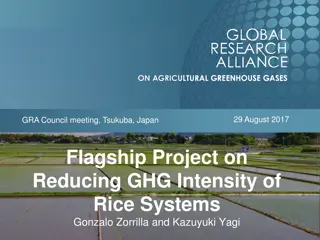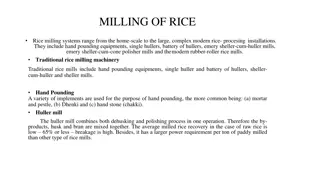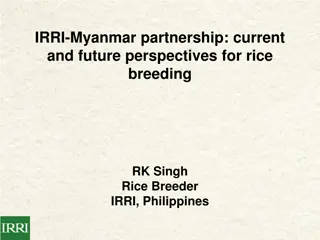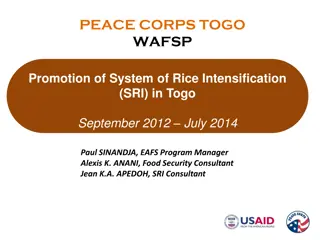
Nutrient Management of Rice for Optimal Crop Production
Enhance rice crop production by understanding nutrient requirements, focusing on nitrogen management, application rates, timing, and efficiency factors. Explore deep placement techniques and nitrification inhibitors for sustainable yield.
Download Presentation

Please find below an Image/Link to download the presentation.
The content on the website is provided AS IS for your information and personal use only. It may not be sold, licensed, or shared on other websites without obtaining consent from the author. If you encounter any issues during the download, it is possible that the publisher has removed the file from their server.
You are allowed to download the files provided on this website for personal or commercial use, subject to the condition that they are used lawfully. All files are the property of their respective owners.
The content on the website is provided AS IS for your information and personal use only. It may not be sold, licensed, or shared on other websites without obtaining consent from the author.
E N D
Presentation Transcript
Cont... RICE Scientific name : Oryza sativa L. Dr. Triptesh Mondal Assistant Professor Department of Agronomy M.S.S.S.O.A., C.U.T.M.
Nutrient management of rice An adequate and balanced supply of plant nutrients is a prerequisite to maximize crop production. The major nutrients required by rice crop are N, P & K. Throughout the rice growing areas in India, N is the most limiting factor. N is usually deficient where rice is grown because the same conditions of climate which favour rice production cause a rapid turn over and loss of N from the soil. 1. NITROGEN Rate of application: For Dwarf and semi dwarf varieties - optimum N rates are 80-100 kg /ha during kharif and 100-120 kg/ha during rabi. A dose of 100-150 kg N/ha is generally recommended for HYVs of rice. Hybrids having yield potential of 8-10 t/ha, will need 180-200 kg N/ha. Thumb rule is 20 kg N/ha is required for production of 1 tonne rough rice. Time of N application : It depends on the (i) Texture of soil (ii) Physiology of the crop (iii) Other field management practices
Efficiency of applied N is higher at active tillering stage than at transplanting and reaches a peak at PI, Beyond PI, the NUE decreases. Therefore, top-dressing of N is suitable at twice 1. Tillering stage, 2. Panicle initiation stage When more splits of N are needed especially in light textured soils, the period between 3 weeks after tillering until 1 to 2 weeks beyond PI may be beneficial. Basal application is necessary in low fertility soils, early maturing varieties (short duration varieties), poor tillering varieties, widely spaced crops etc. A. Split application of N: Application of N at planting and to a lesser extent at tillering, promotes the formation of tillers resulting in more panicles/unit area. Later application of N increases panicle weight which can be obtained with N top-dressing around panicle initiation stage. Application at PI stage increases the length of Flagleaf providing a longer photo synthetically active leaf area. Split application of N have proved to be far better as the efficiency of applied N with split applications is about 30% under transplanted and 59% under direct seeded conditions. Extra grain yields of 13% in kharif & 23% in rabi have been recorded due to split applications. Leaf colour chart, SPAD meters etc. can also be used for increasing the efficiency of split applied N. Two split doses are recommended for short and medium-duration varieties and three split doses are recommended for long-duration varieties.
SPAD meter use in field N top-dressing in rice field Rice LCC use in field
B. Deep placement is considerably important in the case of phosphate fertilizers but it is equally important in case of nitrogenous fertilizers. Ammonia volatilization can almost be prevented by deep placement of N fertilizer. Deep placement of NH fertilizer in the reduced zone can prevent or atleast retard the formation of nitrates and their subsequent loss by denitrification. [For e.g.: In submerged condition, S-oxidizing bacteria (Thiobacillus thioxidans) which uses nitrate as a source of O and consequently reduce it to N or N O in submerged condition, known as denitrification.] C. Nitrification inhibitors: These chemicals can retard the nitrification process in soil and thereby reduce the N loss by leaching and denitrification. Some examples are: N-serve (2-chloro- 6-trichloromethyl pyridine), AM (2-amino-4-chloro-6-methyl pyridine), DCD (Dicyandiamide), ST (Sulpathiazole) etc. Neem (Azadirachta indica) seed extract has also the nitrification inhibiting properties. D. Slow release N fertilizers: These are of 2 kinds, namely (i) coated conventional fertilizers such as SCU (sulphur coated urea) and PCU (polymer-coated urea); (ii) chemicals with inherent slow release of N properties such as IBDU (isobutylidene diurea), CDU (crotonylidene diurea), ureaform etc. Slow-release N fertilizers release N slowly and therefore allow its uptake before it is lost. Deep placement of N:
E. These are based on the principle of chinese mudball technique. Small amount of fertilizer N are placed inside a moist mudball by making a hole and sealing it. Mudballs are then dried and stored for placement in paddy fields. USGs or large-size urea pellets come in different shapes and sizes; the most popular are 1 g (1 cm in diameter) granules. The only problem is in their placement and no low cost USG placement equipment is yet available. Urea supergranules (USGs):
Method of application : Depth of fertilizer placement makes all the differences between efficient use and wastage. The superiority of root zone placement (upto 5 cm depth of soil) of N fertilizers to the surface applications was well established. Surface applications resulted in slight losses of nitrogenous fertilizers in the form of gaseous ammonia. A substantial part (8-20%) of applied N could be lost due to NH volatilization at soil pH 7 or above when N fertilizers are entirely broadcasted. Root zone placement and application of SCU or PCU nearly doubled the NUE than split surface application of nitrogenous fertilizers commonly used by the farmers. Placement of N < 5 cm depth of soil increased the yield by 7-10 q/ha. Incorporation of fertilizers N up to 5 cm depth in the last puddle operation resulted in higher grain yield than all other methods of application. A plough sole application for N placement in root zone will be very useful. Before top-dressing, water is to be drained out completely from field for 1 or 2 days. N is lost through fertilizers as NH volatilization, leaching and denitrification. Among which denitrification losses are most severe under alternate flooded and drained condition (could be upto 72%). Considerable N could be lost by leaching in the upland rice but it is not exceeded 1% in lowland rice. NH volatilization loss can contribute upto 28% loss of applied N in lowland rice fields.
For efficient management of N fertilizers in wetland rice, the following measures have to be followed: 1. Right method of application 2. Optimization of split application of N in relation to growth stages (Right time) 3. Deep placement of N fertilizer in the reducedzone of soil. 4. Use of slow release or controlled release N fertilizers or nitrification inhibitors 5. Combining the concept of slow release and deep placement of N fertilizers 6. Furrows of 6 cm deep are opened with a stake in between rows of plants. Fertilizer is placed in the furrows and then the furrow is closed (i.e., furrow placement) 7. Irrigation water should not let in 24-48 hrs before the fertilizer application
Some functions of N: N imparts dark green colour of leaves i.e., increasing the chlorophyll content of leaves. N promotes rapid plant growth N increases size of leaves and grains N increases protein content in grains Supplies N to microbes while decomposing organic materials
Some functions of P: P stimulates root development It promotes earlier flowering and ripening (especially in cool climates) P encourages more active tillering under adverse conditions It promotes good grain development and gives higher food value
POTASSIUM: The recovery of soil applied K is 40% in tropical condition and in similar range in sub-tropical condition. Potash may become a limiting factor in red & light soils and where leaching losses are likely to be high. Soil application of potash either as MOP also known as KCl (contains 58-60% K O) or SOP also known as K SO (contains 48-50% K O) under deficient conditions will improve yields considerably. Generally, about 20-40 kg K O/ha is recommended as a maintenance dose to keep available potash in the soil above critical limits for high level of production. Potash is applied at the time of last puddling along with P as surface application and incorporated thereafter. Time of application: Recent studies have shown that, top dressing of K at maximum tillering and at or before panicle initiation increased rice yields especially in light textured soils poor in potassium holding capacity. BALANCED NPK FERTILIZATION IS MUST FOR ATTAINING HIGH YIELD.
Some functions of K: K increases plant vigour and diseases resistance in plants It helps in protein production of plants K strengthens the straw and stalks of plants K helps in root development K helps in formation and transfer of starches, sugars and oils It induces plumule development of grains
About 41% of Indian soils are deficient of sulphur. In rice-wheat cropping system, S application to rice is 40 kg/ha or more increased rice yield significantly and also gave a significant residual effect on the succeeding wheat (Tiwari et al., 1997). Symptoms of S deficiency in rice plants: 1. Younger leaves turn yellow 2. S deficiency cannot be corrected even with heavy application of N 3. In S-deficient plants, S levels in plant tissue are lower, while N levels are higher Sources of S: 2 kinds of S fertilizers are available. (i) Fertilizers containing S but used as a source of other nutrient in field. These are: SSP contains 12% S, Ammonium sulphate (24% S), ammonium sulphate nitrate i.e., ASN (15% S) etc. (ii) Fertilizers are used as the source of S only. These are: Elemental S, gypsum (CaSO ), iron pyrites, chalkopyrites etc. Method of application: S fertilizers are also best applied as basal by broadcasting at the time of last ploughing (in direct-seeded rice) & broadcasting then incorporating in the last puddling (in transplanted rice). SULPHUR: Gypsum
Micronutrients ZINC: Zinc (Zn) is an essential micro nutrient for rice. It is required in auxin production and activation of many enzymes. Its deficiency is associated with soils of high pH. Zn deficiency causes brown spots on the youngs leaves 1st than spread to lower leaves. Zn deficiency in rice is known as Khaira disease. Correction of Zn deficiency In India, Soil application @ 40-50 kg ZnSO heptahydrate/ha (For normal soils once in 3 yrs.). This fertilizer contains 21% Zn. Zn coated urea can also be used (0.5 to 2% Zn) for Zinc application. By dipping the seedlings in 2% suspension of ZnO is both cheap and convenient. Seed coating is a new development. At present this technique is being used in limited scale in drilled or direct-seeded rice production. IRON : If iron deficiency is noticed spraying of 1.5% ferrous ammonium sulphate + 75 g citric acid/1litre of water at 4 to 5 days interval till the leaves turn to normal growth. Fe toxicity causes bronzing of leaves and deficiency causes pale green upper leaves which may belach in acute deficiency. Boron: Deficiency mainly found in red and lateritic soils of West Bengal and Orissa. Application of borax @ 10 kg/ ha or spraying of 2% borax solution is effective.
BIOFERTILIZERS: Some microbes are capable of fixing atmospheric N, while some can increase the availability of N & P. Definition: Biofertilizers are the microbial inoculants refers to the living or latent cells of efficient strains of micro-organisms capable of fixing atmospheric N when applied to seed or plant surfaces or soil or composting area, promote growth by several mechanisms such as increasing the supply of nutrients, increasing root biomass and root area and increasing nutrient uptake capacity of plants. Free living organisms : Important microbes fixing atmospheric N are BGA, Azolla, Azotobacter & Azospirillum. Among them, BGA and Azolla can survive only in lowland conditions. 1. BGA : Several species of BGA can fix N. The most important species are Anabaena and Nostoc. The amount of N fixed by BGA ranges from 15-45 kg N/ha; standing water of 2 to 10 cm in the field is a prerequisite for growth of BGA at a temperature of 25-45 C and pH of 7-8 with high organic matter in soils. Bright sunshine increases the growth rate. BGA inoculum is applied after transplanting of rice @ 10 kg/ha. For higher N fixation, 3-4 tonnes of FYM/ha + 200 kg SSP/ha.
Azolla : It is a free floating fresh water fern. Azolla pinnata is the most common species occurring in India. It fixes N due to Anabaena sp. of BGA present in the lobes of Azolla leaves. A thick mat of Azolla supplies 30-40 kg N/ha. Unlike BGA, it thrives well at low temperatures. It grows at a temperature of 20-30 C and soil pH of 5.5 7.0. It grows better during monsoon season with frequent rains and cloudiness. Azolla is applied to the main field as a green manure crop and as a dual crop. As green manure crop, it is allowed to grow on flooded soils for 2-3 wks before transplanting. Later, water is drained and Azolla is incorporated by ploughing in situ. As a dual crop, 1000-5000 kg/ha of Azolla is applied to the soil one week after transplanting. When a thick mat forms, it is incorporated by trampling. The left over Azolla develops again which is trampled in as a 2nd crop. For better growth of it, 25-50 kg of SSP/ha is applied and standing water of 5-10 cm is maintained continuously in the rice fields. Azolla Blue-green algae
INTEGRATED NUTRIENT MANAGEMENT (INM)/INTEGRATED PLANT NUTRIENT SUPPLY SYSTEM (IPNS): Plant nutrients can be supplied from different sources viz., organic manures, green manure, brown manure, crop residues, biofertilizers and chemical fertilizers. For better utilization of resources and to produce crops with less expenditure, INM or IPNS is the best approach. In this approach, all the possible sources of nutrients are applied based on economic consideration and the balance required for the crop is supplemented with chemical fertilizers. Application of organic matter in any form reduces loss of N fertilizer and increases FUE.
WEEDS AND THEIR MANAGEMENT Weeds reduce the grain yield of rice by 24-48% as they compete with the crop for nutrients, sunlight, water and space. Weeds also reduce the quality of crop produce. In transplanted rice it is 15-20%, in wet directed-seeded rice 30-35% and in dry direct-seeded rice/upland rice about 50% loss occurs. The potential loss in production of rice in India due to weed infestation is estimated at 15 million tonnes/annum. Three types of weeds are found in rice fields. These are: i) Grasses : Monocots, two ranked leaves e.g.: Echinochloa colonum, Echinochloa crussgalli, Cynodon sp., Panicum sp. ii) Sedges : Similar to grasses but have 3 ranked leaves and triangular solid stems. They frequently have modified rhizomes adopted for storage and for propagation. Sedges belong to the family Cyperaceae, a large family of monocotyledonous plants distinguished chiefly by having active solid stems and 3 ranked leaves. e.g. : Cyperus rotundus, Cyperus iria, Fimbristylis miliaceae iii) Broad leaved weeds : Dicots e.g.: Eclipta alba, Commelina benghalensis, Ammonia baccifera
2 ranked leaves 3 ranked leaves
Crop weed competition : Optimum yield were obtained where the minimum duration of weed control is from 20-30 days. Weed control - Manual, mechanical & chemical weed control In rice nursery/wet direct-seeded rice: Echinochloa colonum & Echinochloa crussgalli are major problematic weeds. We can apply the following herbicides: (i) Thiobencarb (Saturn) @ 2.5 -5 lit/ha to be sprayed either on 3rd or 7th DAS will effectively control Echinochloa sp. without phytotoxicity to the rice seedlings. (ii) Propanil (Stam F-34) can be sprayed @ 3.25 lit/ha at 12-15 days of rice nursery. This herbicide should not follow or precede the application of any fungicide/insecticide. (iii) Pre-emergence application of Butachlor (Machete) @ 1 kg/ha at 8 DAS In transplanted rice : (i) 2, 4-Diethyl ester granules @ 20-25 kg/ha (0.8-1 kg a.i/ha) applied 3-5 DAT will give better weed control. (ii) 2, 4-Dielthyl ester granules at 10 kg/ha + thiobencarb @ 2.5 lit/ha mixed with sand and applied at 3-5 DAT will be useful when the fields are infested with Echinochloa sp. In Upland rice/dry-direct-seeded rice: (i) 2, 4-D ester @ 0.9 kg a.i./ha at 25 DAS was found effective.
THRESHING Husk is separated, used as domestic & commercial fuel and also used to make silica gel, charcoal and sodium silicate. It contains 20% ash, 90% of which is silica. Three types of threshing are: 1. Hand threshing of sheaves : This type of threshing is done against some hard surface like stone, wooden plank, a bench etc., This is practical when the quantity is small and also for when it is for seed purpose. 2. Cattle/Bullock threshing : It is adopted when large quantity is to be handled. First, a threshing floor is prepared well by removing stubbles, compacting etc., in a circular fashion and the sheaves are spread and trampling under the feet of cattle/bullock is made to go round and round. 3. Tractor threshing : Now a days, it is widely adopted practice. The sheaves are heaped on the threshing floor in a circular fashion and the tractor goes round and round. In advanced countries, there will be combined thresher and winnowers.
MILLING It is done before consumption of rice. In the process of milling, the aleurone layer and embryo are removed during the polishing of rice grain. All the grain constituents except the carbohydrates are reduced by the process of polishing. There is a loss of Vitamin B1 or thiamine, the deficiency of which causes the disease called beriberi in those persons who continuously eat polishedrice The loss of nutrients in parboiled rice, during the process of milling & washing with water before cooking, is much less than that in white milled rice. Hand pounding (the bran is retained) of rice gives a higher recovery as well as more nutritious rice grain. HP rice is high in fibre, proteins & selenium (Se). Rice bran is the aleurone layer separated from brown rice containing 12-15% protein, 14-25% oil and rich in vitamin B-complex. It is used for rice oil extraction and also as animal feed.
Rice milling Rice milling Rice Bran Rice Bran
YIELDS It varies from season to season, and variety to variety besides several other factors. While the average yields vary from 4-5 tons/ha during kharif. A minimum of 1 more tonne can be expected during rabi for a HYV. Industrial uses: 75-80 lakh tonnes of paddy straw; supplemental source of raw material for paper industry. 4 mini paper mills can produce - 55000 tons paper & straw boards. Reasons for low yields of rice: 1. Widely varying climatic conditions under which rice is grown. 2. Inefficient utilization of applied N 3. Limited scope for optimum water management in heavy rainfall areas. 4. Cloudiness and its ill effects on the photosynthetic activity of rice in monsoon (80% of the kharif season prevails cloudy weather) 5. Adverse effects of soil salinity or alkalinity (0.024 m ha in AP & 7 m ha in India) 6. Susceptibility to heavy incidence of pests and diseases which tend to increase under ideal crop conditions. 7. Little scope for rainfed upland rice to achieve its yield potential fully due to short growing period and practically no control over time of transplanting even in assured rainfall areas without irrigation facilities. 8. Indiscriminate use of fertilizers 9. Monoculturing 10. Poor drainage (10 lakh ha suffer in this zone & 40 m ha in India)
Measures to improve the yield: 1. Tailoring new varieties which can effectively photosynthesize even under low light intensity . e.g.: IET 9354, Vijaya etc. Effective control of pests and diseases and growing of resistant varieties. Growing varieties tolerant to salinity. e.g.: MCM-1 ; MCM-2 ; SR-26-B, CSR 10, CSR-46, Lunisree etc. Increasing cropping intensity through early maturing modern rice varieties. Adopting best agronomical practices like adjusting the date of planting in a given locality in such a way that the last 6 weeks of a variety pass through cloud free days. 2. 3. 4. 5.
PARBOILING IN RICE It is actually partial boiling of the paddy before milling . A hydrothermal treatment of rice grain immediately followed by drying prior to milling to prepare parboiled grains is called parboiling. It is a hydrothermal process in which the crystalline form of starch is changed in to an amorphous form on account of irreversible swelling and fusion of starch. Head recovery is improved because suncracks are partly taken care of. Vitamins & micronutrients present in aleurone layer of rice kernel, move in grain on parboiling. Rice grain consists chiefly of an endosperm embodying polygonal starch granules. The air and the moisture fill up the intergranular spaces. The soaking of a grain either in cold or hot water results in swelling of the starch granules. Soaking in hot water weakens the granule structure by way of breaking the hydrogen bond which consequently provides a larger surface for the absorption of water by the starch granules. The whole process is called gelatinization. Later on, moist heating is done to provide the irreversible swelling or the fusion of the starch granules. Steam is mostly used for moist heating.
Advantages : 1. Easily to shell out the parboiled rice. 2. The percentage of broken grains is reduced (Extra strength is provided) 3. More nutritious than raw rice 4. Renders more resistant to insects during storage. 5. Loss of solids in gruel is less than raw rice during cooking. 6. The bran from parboiled rice contains higher oil content. It is better owing to lower contest of the free fatty acids. Disadvantages: 1. Due to destroying of natural oxidants, rancidity may develop 2. Parboiled rice takes more time to cook. 3. Common rice consumer may not like the flavour and colour of the parboiled rice. 4. Parboiled rice may contain higher moisture content and some mycotoxins may develop. 5. Drying of parboiled rice to a safe moisture content for storage entails extra expenditure. 6. The milling cost of parboiled rice is higher since the shelled grains are comparatively harder.
Transformation of New Plant Type lines of rice through biolistic and protoplast methods: The New Plant Type (NPT) with distinct morphological characters, such as thick and sturdy stems, dark green thick erect leaves, low numbers of tillers, large panicles with high number of grains, high harvest index (0.6) and short stature (90-100 cm), has been developed to increase the yield potential of rice by 20-25% (Khush, 1995). However, additional breeding work is underway to incorporate genes for disease and insect resistance into these lines. The successful introduction of gus and hph genes into NPT lines through transformation indicated the possibility of introducing agronomically important genes into these lines.
5 selected lines of New Plant Type (IR65598-112-2, IR65600-1-2-3, IR65600-42-5-2, IR66738-118-1-2, and IR66743-41-2-2) were used. Both biolistic (Christou et al. 1991) and protoplast (Datta et al. 1990, 1992) methods were used for transformation. Three kinds of explants e.g. immature embryos, embryogenic calli and embryo-genic cell suspensions were used for particle bombardment. Isolated protoplast from 1 -3 month old suspensions were used for PEG (polyethylene glycol/polyethylene mediated transformation. oxide/polyoxyethylene) Plasmid, pGHi (carrying gus and hph genes) and pGL2 (carrying only hph gene) were used for both methods of transformation. The fertility of the primary transformants ranged from 70-80%. No abnormal morphological features were observed excepting reduced height. This initial success is encouraging for developing transgenic NPT plants with agronomically important genes such as bt (Bacillus thuringiensis) and chitinase.





